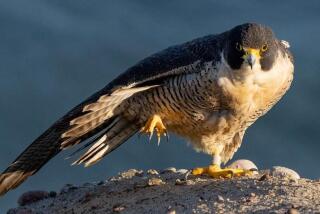Sacramento’s Rare Falcon Has Friend in High Places
- Share via
SACRAMENTO — The rare peregrine falcon that took up residence in the capital last fall has been sighted in the company of a second falcon, giving state wildlife officials hope that the birds will nest and raise a family on the roof of their building.
Terrence M. Eagan, undersecretary of the state Resources Agency, said Tuesday that the two birds were observed “soaring and darting in tandem” outside the agency’s headquarters.
“It was a surprise to see two of them, especially in the downtown area,” said Gordon Snow, an assistant secretary of Resources who watched for half an hour Monday as the birds circled outside his 13th-floor office. “Seeing two of them tells me perhaps they’re going to set up housekeeping.”
The falcons’ maneuvers in the capital on Monday undoubtedly struck fear into the hearts of the local pigeon population. The city birds, much smaller than the falcons, could be seen scattering in all directions to avoid being taken on the wing.
The peregrine, considered the aristocrat of birds of prey, is known for hunting down other birds and plucking them from the air at speeds of more than 200 m.p.h. In urban areas, falcons have been known to eat an average of a pigeon a day.
The capital’s first falcon, believed to be a female, was sighted last September after one state official found the head of a teal duck on the sidewalk near his office. A variety of other bones and pigeon parts were later discovered on the roof of the Resources building, where the rare bird was roosting.
As it happens, the Resources Agency is responsible for overseeing the recovery of the peregrine falcon, as well as other endangered species.
The peregrine falcon, like other large birds of prey, was nearly wiped out in the 1960s by the pesticide DDT. The insecticide, which is passed up through the food chain, causes the shell of the peregrine’s egg to crack easily, making reproduction nearly impossible. In 1970, state biologists could find only two breeding pairs of peregrines in California.
Now, 83 pairs are known to nest in the state, including some that have been raised in captivity and set free in Los Angeles, where they roost on skyscrapers and thrive on a diet of pigeons.
“The peregrines are coming back, I think,” Snow said optimistically. “It’s not nearly as critical as it once was.”
Ever since the first falcon arrived in the fall, wildlife officials have hoped that the bird would find a mate and nest on the roof of the 16-story Resources building, one of the tallest in the Capital.
“It would be a real kick if they did set up a family up there,” Eagan said.
More to Read
Sign up for Essential California
The most important California stories and recommendations in your inbox every morning.
You may occasionally receive promotional content from the Los Angeles Times.










